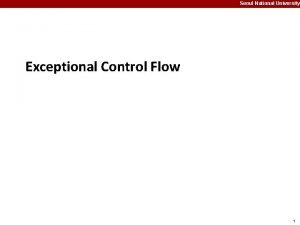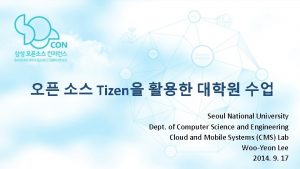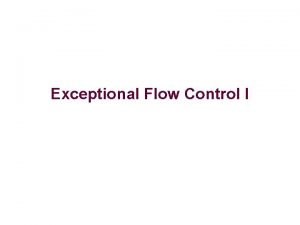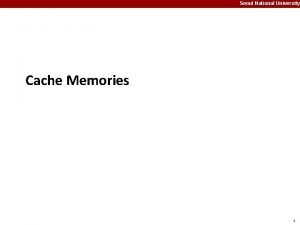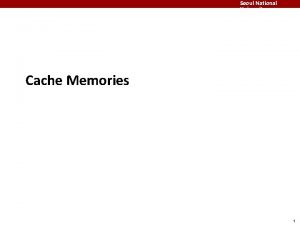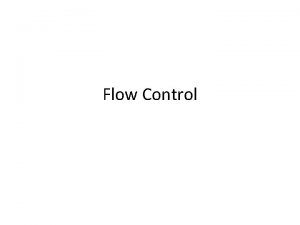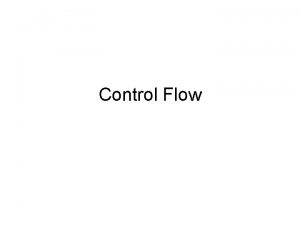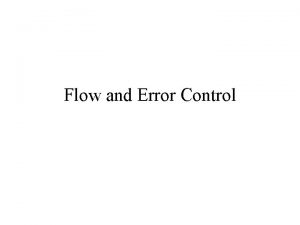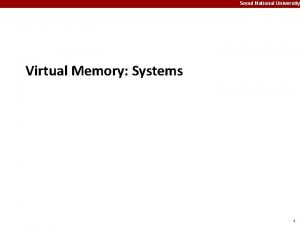Seoul National University Exceptional Control Flow 1 Seoul










![Seoul National University Fault Example: Invalid Memory Reference int a[1000]; main () { a[5000] Seoul National University Fault Example: Invalid Memory Reference int a[1000]; main () { a[5000]](https://slidetodoc.com/presentation_image/7ba13c76af1223d16db5434280bf89e5/image-11.jpg)

- Slides: 12

Seoul National University Exceptional Control Flow 1

Seoul National University Control Flow ¢ Processors do only one thing: § From startup to shutdown, a CPU simply reads and executes (interprets) a sequence of instructions, one at a time § This sequence is the CPU’s control flow (or flow of control) Physical control flow Time <startup> inst 1 inst 2 inst 3 … instn <shutdown> 2

Seoul National University Altering the Control Flow ¢ Up to now: two mechanisms for changing control flow: § Jumps and branches § Call and return Both react to changes in program state ¢ Insufficient for a useful system: Difficult to react to changes in system state § § ¢ page fault occurs data arrives from a disk or a network adapter instruction divides by zero System timer expires System needs mechanisms for “exceptional control flow” 3

Seoul National University Exceptional Control Flow ¢ ¢ Exists at all levels of a computer system Low level mechanisms § Exceptions change in control flow in response to a system event (i. e. , change in system state) § Combination of hardware and OS software § ¢ Higher level mechanisms (will be covered in the system software course) § § Process context switch Signals Nonlocal jumps: setjmp()/longjmp() Implemented by either: § OS software (context switch and signals) § C language runtime library (nonlocal jumps) 4

Seoul National University Exceptions ¢ An exception is a transfer of control to the OS in response to some event (i. e. , change in processor state) User Process event I_current I_next OS exception processing by exception handler • return to I_current • return to I_next • abort ¢ Examples: div by 0, arithmetic overflow, page fault, I/O request completes 5

Seoul National University Exception Tables Exception numbers code for exception handler 0 Exception Table 0 1 2 n-1 . . . code for exception handler 1 code for exception handler 2 . . . ¢ ¢ ¢ Each type of event has a unique exception number k k = index into exception table Handler k is called each time exception k occurs code for exception handler n-1 6

Seoul National University Asynchronous Exceptions (Interrupts) ¢ Caused by events external to the processor § Indicated by setting the processor’s interrupt pin § Handler returns to “next” instruction ¢ Examples: § I/O interrupts arrival of data from a disk § arrival of a packet from a network § Hard reset interrupt § hitting the reset button § Soft reset interrupt § hitting Ctrl-Alt-Delete on a PC § 7

Seoul National University Synchronous Exceptions ¢ Caused by events that occur as a result of executing an instruction: § Traps Intentional § Examples: system calls § Returns control to “next” instruction § Faults § Unintentional but possibly recoverable § Examples: page faults (recoverable), protection faults (unrecoverable), div by 0 § Either re-executes faulting (“current”) instruction or aborts § Aborts § unintentional and unrecoverable § Examples: parity error, machine check § Aborts current program § 8

Seoul National University Trap Example: Opening File ¢ ¢ User calls: open(filename, options) Function open executes system call instruction int 0804 d 070 <__libc_open>: . . . 804 d 082: cd 80 804 d 084: 5 b. . . User Process int pop $0 x 80 %ebx OS exception open file returns ¢ ¢ OS must find or create file, get it ready for reading or writing Returns integer file descriptor 9

Seoul National University Fault Example: Page Fault ¢ ¢ User writes to memory location That portion (page) of user’s memory is currently on disk 80483 b 7: c 7 05 10 9 d 04 08 0 d User Process movl ¢ ¢ movl $0 xd, 0 x 8049 d 10 OS exception: page fault returns ¢ int a[1000]; main () { a[500] = 13; } Create page and load into memory Page handler must load page into physical memory Returns to faulting instruction Successful on second try 10
![Seoul National University Fault Example Invalid Memory Reference int a1000 main a5000 Seoul National University Fault Example: Invalid Memory Reference int a[1000]; main () { a[5000]](https://slidetodoc.com/presentation_image/7ba13c76af1223d16db5434280bf89e5/image-11.jpg)
Seoul National University Fault Example: Invalid Memory Reference int a[1000]; main () { a[5000] = 13; } 80483 b 7: c 7 05 60 e 3 04 08 0 d User Process movl $0 xd, 0 x 804 e 360 OS exception: page fault detect invalid address signal process ¢ ¢ ¢ Page handler detects invalid address Sends SIGSEGV signal to user process User process exits with “segmentation fault” 11

Seoul National University Exception Table IA 32 (Excerpt) Exception Number Description Exception Class 0 Divide error Fault 13 General protection fault Fault 14 Page fault Fault 18 Machine check Abort 32 -127 OS-defined Interrupt or trap 128 (0 x 80) System call Trap 129 -255 OS-defined Interrupt or trap Check Table 6 -1: http: //download. intel. com/design/processor/manuals/253665. pdf 12
 Exceptional control flow
Exceptional control flow The illusion of life
The illusion of life Seoul national university computer science
Seoul national university computer science Seoul national university medical school
Seoul national university medical school Undergraduate graduate postgraduate
Undergraduate graduate postgraduate Data flow vs control flow
Data flow vs control flow Control flow and data flow computers
Control flow and data flow computers Transaction flow testing
Transaction flow testing Stock control e flow control
Stock control e flow control Control flow error
Control flow error Raleigh and rosse case study solution
Raleigh and rosse case study solution Exceptional children 10th edition
Exceptional children 10th edition Exceptional learners: an introduction to special education
Exceptional learners: an introduction to special education
